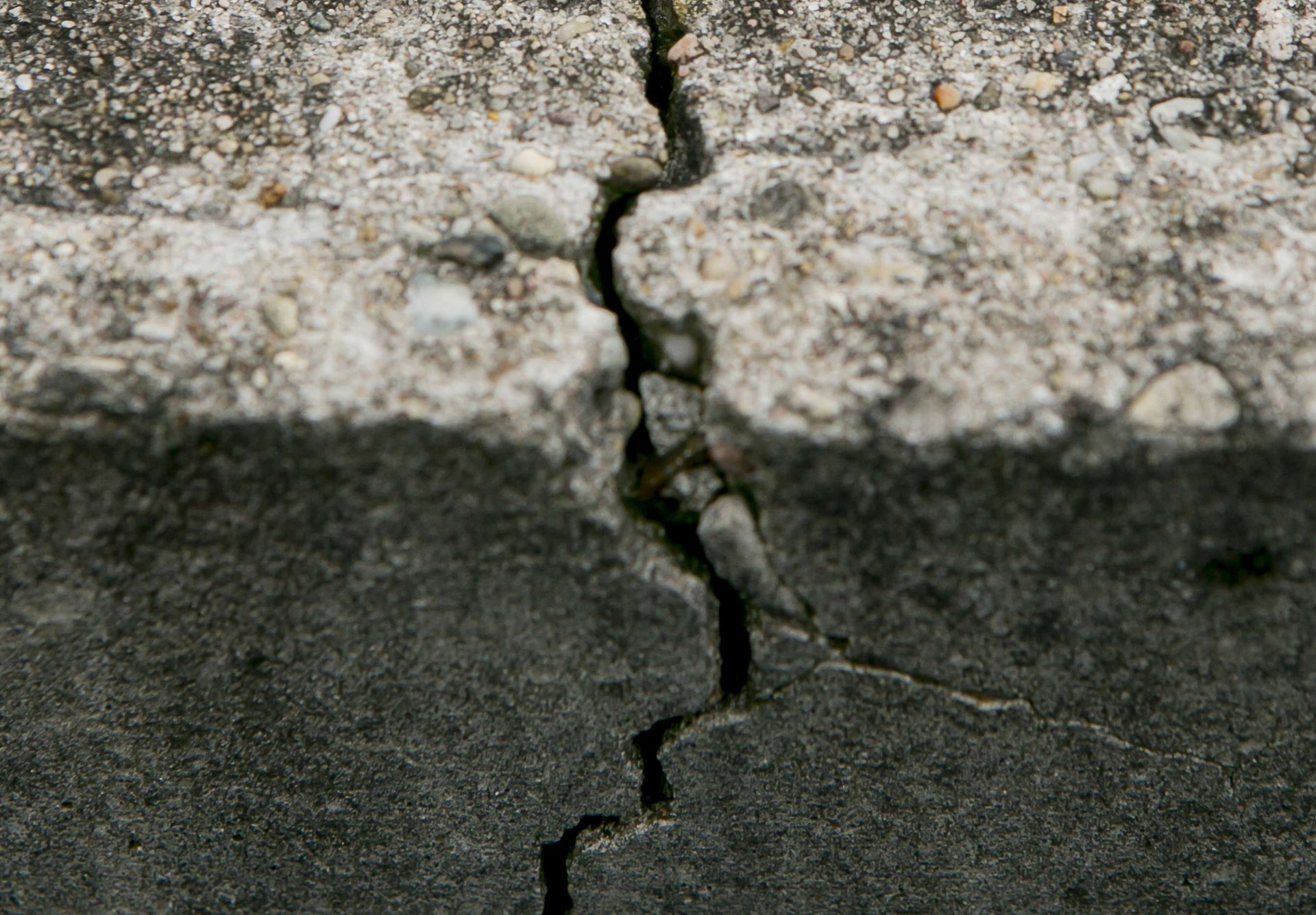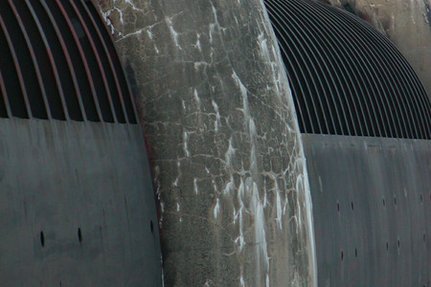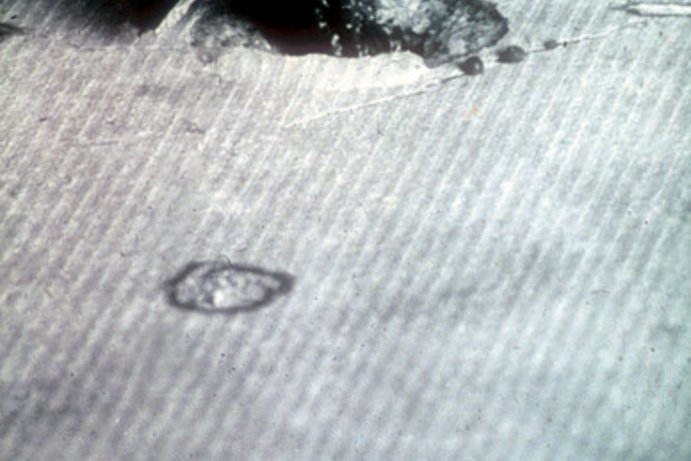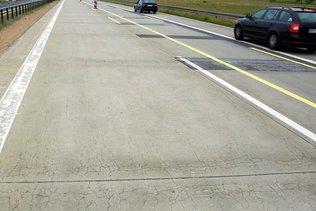In an alkali-silica reaction (ASR) alkali-reactive siliceous constituents of the aggregates react with the alkali and hydroxide ions (K⁺, Na⁺ and OH⁻) in the pore solution of the concrete to swellable alkali silica gel. Under adverse conditions, the volume of the alkali silicate gel may gradually expand to such an extent as to cause localised swelling pressure. This can damage the concrete microstructure and lead to cracking, efflorescence and spalling. Experts speak of a "damaging ASR", while colloquially the term "concrete cancer" is used. The durability of the concrete may be affected, although the stability of the components is not normally at risk. It usually takes 5 to 10 years or more for such damage to appear.
The requirements for a damaging ASR in concrete (concrete cancer) are:
- a sufficient supply of water
- a sufficiently high alkali hydroxide concentration in the pore solution of the concrete
- alkali-reactive aggregates
In order to avoid damage resulting from alkali-silica reactions (ASR) the alkali reactivity of aggregates or concrete compositions must be known so that, if necessary, appropriate measures can be taken. Tests on the alkali reactivity of aggregates can be carried out in accordance with the Alkali Guidelines stipulated by the German Committee for Structural Concrete (DAfStb), according to TP Beton-StB or according to RILEM. In cases where the Alkali Guidelines stipulate the substitution of the aggregate or the use of cement with low effective alkali content (na cement acc. to DIN 1164-10) the alkali reactivity of a concrete composition can also be proved by an ASR performance test to ensure that aggregates or cements are not unnecessarily excluded from use.
Regulations
In Germany, the alkali guidelines issued by the German Committee for Structural Concrete (DAfStb) specify measures designed to prevent the occurrence of any damaging ASR. To determine preventative measures, it is necessary to characterise the ambient conditions of the concrete by means of the moisture class and the alkali-reactivity potential of the aggregate. For this purpose, every aggregate according to DIN EN 12620 to be used in Germany for concrete in accordance with EN 206/DIN 1045-2 needs to be categorised by an alkali reactivity-class. Preventative measures have to be taken in the case of certain combinations of moisture class, alkali reactivity-class and the cement content (if any) of the concrete. The alkali guidelines include test methods as well as criteria for the categorisation of aggregates into one of the alkali reactivity-classes, in addition to preventative measures based on concrete technology. A damaging ASR can basically be prevented in two ways:
- replacement of the alkali-reactive aggregate
- reduction of the alkali content in the pore solution of the concrete.
The second measure can be achieved by using special cements with low effective alkali content. In Germany these cements are specially identified by the designation „(na)“.
In many cases alkali-reactive aggregates in concrete can also be used for structures in the building and structural engineering sector without any need for special measures. This, however, depends on the composition of the concrete (cement content) and the environment (moisture class).
In the case of concrete road surfaces (e.g. on airport runways or freeways), the ASR damage potential is particularly high due to alkalis in the de-icing agents which can penetrate the concrete from the outside. For this reason, the General Circular on Road Construction (ARS) No. 04/2013 issued by the Federal Ministry of Transport and Digital Infrastructure (BMVI) specifies requirements for concrete traffic surfaces that are intended to reliably prevent ASR damage in road surfaces. According to ARS No. 04/2013, the alkaline harmlessness of coarse aggregates and of concretes of moisture class WS must be proven. VDZ Technology gGmbH is recognized as an AKR expert by the Federal Ministry of Transport and Digital Infrastructure (BMVI) and the Federal Highway Research Institute (BASt) respectively.
Our methods
Testing of the alkali-reactivity potential of aggregates | |
| Service | Method |
| Accelerated mortar bar test (AMBT) at 80°C | Alkali Guidelines, TP B-StB 1.1.11 or RILEM AAR-2 |
| Mortar bar test at 70°C | Alkali Guidelines (2007) or TP B-StB 1.1.12 |
| Concrete test with fog chamber storage at 40 °C | Alkali Guidelines |
| Accelerated concrete prism test at 60 °C | Alkali Guidelines or RILEM AAR-4.1 |
Testing of the resistance of concrete compositions to alkali-silica reactivity (ASR performance testing) | |
| Service | Method |
| Concrete prism test at 60 °C without alkali supply | NF P 18-454 or RILEM AAR-11 |
| Concrete prism test at 60 °C with alkali supply | TP B-StB 1.1.09 or RILEM AAR-12 |
| Concrete prism test at 38 °C | RILEM AAR-10 |
| Concrete test at 60 °C on two drilled core halves (with or without alkali supply) | VDZ Method |
| Concrete test with fog chamber storage at 40 °C with cored specimens | VDZ Method |
| Analysis of damage resulting from deleterious ASR | Reflected light microscopy, transmitted light microscopy, and scanning electron microscopy |
Expertise on the alkali harmlessness of aggregates and concrete compositions according to ARS No. 04/2013 (moisture class WS)
In the case of concrete pavements according to ZTV Beton-StB of load classes Bk 100 to Bk 1.8 according to RStO (e.g. freeways), special requirements are specified by TL Beton-StB 07 and by the General Circular on Road Construction (ARS) No. 04/2013 of the Federal Ministry of Transport and Digital Infrastructure (BMVI) due to the high dynamic stress and the alkali supply from outside through road salt.
1.) ASR performance testing
In recent years ASR performance test methods have been developed to investigate whether a damaging ASR can be excluded for a specific concrete composition. The advantage of this approach is that the interaction of the individual concrete constituents is evaluated instead of individual constituents. When new concrete pavements are nowadays built, ASR damage can be more reliably prevented by investigating the potential of the concrete composition for ASR damage by carrying out ASR performance tests prior to installation.
2.) WS basic test
According to ARS No. 04/2013 the suitability of coarse aggregates for concrete belonging to the moisture class WS can be verified by means of “WS basic testing”. Such testing firstly involves determining the alkali-reactivity of all fractions of the excavation site to be used in concrete road surfaces with the help of an accelerated test method (accelerated mortar bar test at 80 °C according to the Alkali Guidelines of DAfStb or mortar bar test at 70 °C according the Alkali Guidelines of DAfStb, 2007 edition). This is carried out on three samples to take account of natural deviations. These results are used to determine the mineralogical/petrographical characteristics and to perform testing using the “WS concrete test” for selected fractions. Depending on the concrete composition used, a distinction is made between “WS basic testing” for concrete with a maximum aggregate size of 8 mm for the fraction to be used (top layer concrete (0/8)) and for concrete with a maximum particle size > 8 mm (top layer concrete (D>8) and bottom layer concrete).
3.) WS confirmation test
Where a concrete passes ASR performance testing or where an aggregate passes WS basic testing, the concrete or the aggregate can then be assessed by means of a “WS confirmation test” at short notice and may be used for the construction of road surfaces if there is sufficient conformity with initial values. To assess the level of conformity, accelerated mortar bar tests and mineralogical/petrographical investigations are carried out on current aggregate samples. Suitability can be confirmed either by third-party inspection on a regular basis or in a test carried out once prior to the start of casting the concrete in a building project. In the case of concretes the other concrete constituents should also undergo testing.




